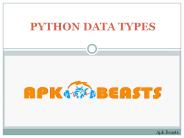Python Syntax - PowerPoint PPT Presentation
Title:
Python Syntax
Description:
This presentation educates you about Python syntax, Python Identifiers, Naming conventions for Python identifiers, Reserved Words, Lines and Indentation, Multi-Line Statements, Quotation in Python, Comments in Python, Multiple Statements on a Single Line and Multiple Statement Groups as Suites. For more topics stay tuned with Learnbay. – PowerPoint PPT presentation
Number of Views:72
Title: Python Syntax
1
Python Syntax
Swipe
2
Python syntax
The syntax of the Python programming language is
the set of rules that defines how a Python
program will be written and interpreted (by both
the runtime system and by human readers). The
Python language has many similarities to Perl,
C, and Java. However, there are some definite
differences between the languages.
3
Python Identifiers
A Python identifier is a name used to identify a
variable, function, class, module or other
object. An identifier starts with a letter A to
Z or a to z or an underscore (_) followed by
zero or more letters, underscores and digits (0
to 9). Python does not allow punctuation
characters such as _at_, , and within
identifiers. Python is a case sensitive
programming language. Thus, Manpower and
manpower are two different identifiers in Python.
4
Naming conventions for Python identifiers
Class names start with an uppercase letter. All
other identifiers start with a lowercase
letter. Starting an identifier with a single
leading underscore indicates that the identifier
is private. Starting an identifier with two
leading underscores indicates a strongly private
identifier. If the identifier also ends with two
trailing underscores, the identifier is a
language-defined special name.
5
Reserved Words
The following list shows the Python keywords.
These are reserved words and you cannot use them
as constant or variable or any other identifier
names. All the Python keywords contain lowercase
letters only. and exec not assert finally or
break for pass class from print
6
Lines and Indentation
Python provides no braces to indicate blocks of
code for class and function definitions or flow
control. Blocks of code are denoted by line
indentation, which is rigidly enforced. The
number of spaces in the indentation is variable,
but all statements within the block must be
indented the same amount. For example - if
True print "True" else print "False"
7
Multi-Line Statements
Statements in Python typically end with a new
line. Python does, however, allow the use of the
line continuation character (\) to denote that
the line should continue. For example - total
item_one \ item_two \ item_three Statements
contained within the , , or () brackets do
not need to use the line continuation
character. For example - days 'Monday',
'Tuesday', 'Wednesday', 'Thursday', 'Friday'
8
Quotation in Python
- Python accepts single ('), double (") and triple
(''' or """) quotes to denote string literals,
as long as the same type of quote starts and
ends the string. - The triple quotes are used to span the string
across multiple lines. For example, all the
following are legal -
word 'word' sentence "This is a sentence."
paragraph """This is a paragraph. It is made
up of multiple lines and sentences.
9
Comments in Python
A hash sign () that is not inside a string
literal begins a comment. All characters after
the and up to the end of the physical line are
part of the comment and the Python interpreter
ignores them. Input !/usr/bin/python First
commentprint "Hello, Python!" second
comment Output Hello, Python!
10
Multiple Statements on a Single Line
- The semicolon ( ) allows multiple statements on
the single line given that neither statement
starts a new code block. Here is a sample snip
using the semicolon - - import sys x 'foo' sys.stdout.write(x '\n')
11
Multiple Statement Groups as Suites
A group of individual statements, which make a
single code block are called suites in
Python. Compound or complex statements, such as
if, while, def, and class require a header line
and a suite. Header lines begin the statement
(with the keyword) and terminate with a colon (
) and are followed by one or more lines which
make up the suite. For example - if expression
suite elif expression suite else suite
12
Topics for next Post
Python Variable Types Python Operations Stay
Tuned with















![Best Python Certification Training Course Online [Updated 2021] PowerPoint PPT Presentation](https://s3.amazonaws.com/images.powershow.com/9663694.th0.jpg?_=20210923075)















